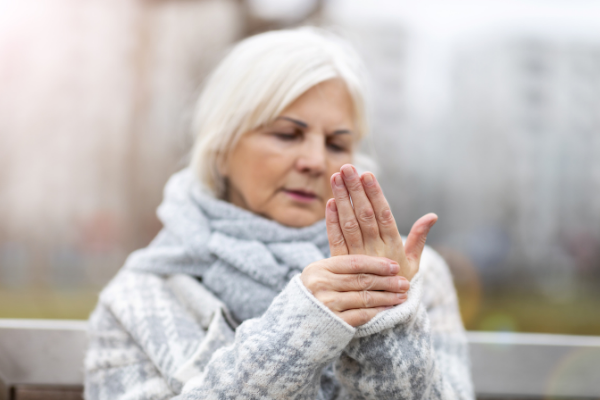
Arthritis is a degenerative condition that causes pain and inflammation in the joints. While pain comes and goes for some people, it’s continuous for others, making arthritis pain management essential. There are medications that can help with arthritis, but there are also natural ways to combat arthritis pain. Take a look at how to relieve arthritis pain naturally with 10 tips and ideas!
What is Arthritis?
Arthritis is a disease that affects your joints, causing pain, inflammation and stiffness. It’s a relatively common condition and most typically affects the hands, feet, hips, knees and lower back. It usually involves inflammation or breakdown of your joints and often makes it difficult for you to move or stay active. The symptoms of arthritis usually develop overtime but they can also appear suddenly. While it most often develops in older adults, it can also affect children, teens and younger adults.
Arthritis involves wear and tear damage to the joint’s cartilage (the coating on the ends of the bones where they form a joint). Cartilage cushions the ends of the bones and allows almost frictionless joint movement. Enough damage can result in bone grinding directly on bone, which causes pain and restrictive movement. If the cartilage in a joint is severely damaged, the joint lining can become inflamed or swollen.
What Are the Symptoms of Arthritis?
Arthritis symptoms can range from mild to severe. They may come and go or they could stay constant. Here are some of the most common symptoms of arthritis:
1. Pain, stiffness, swelling or tenderness in one or more joints
2. Redness and warmth in the affected joint(s)
3. Pain and stiffness that worsens with inactivity and improves with physical activity
4. Reduced range of motion
5. Difficulty sitting or bending over
6. Difficulty gripping objects
7. Clicking or popping with bending
8. Muscle weakness around the joint(s)
9. Bony growths in the fingers
What Causes Arthritis?
1. Genetics: You may be more likely to develop arthritis if your parents or siblings have it
2. Age: The risk of developing arthritis increases with age
3. Previous joint injury: If you’ve injured a joint, let’s say through sport, you’re more likely to develop arthritis in that joint
4. Obesity: Excess weight puts stress on joints, particularly your knees, hips and spine. People with obesity are more likely to develop arthritis.
How to Relieve Arthritis Pain Naturally: 10 Tips
1. Physical Activity
Arthritis can feel worse when you don’t do any type of physical activity. Since being overweight can make you more likely to get arthritis and make it worse, exercise will help you maintain a healthy weight, and this will reduce the pressure on your joints. Staying physically active will keep your muscles around your joints strong, which will help support and stabilize any joint affected by arthritis.
2. Try Heat Therapy
Applying heat to painful joints can help ease discomfort. It can increase blood flow to sore muscles, loosen stiff joints and distract the brain from pain. Try taking a hot bath or shower, use a hot water bottle or heat up a gel-filled pad in the microwave.
3. Cold Treatments
Cole therapy can work too. Arthritis typically comes with painful joint inflammation. Cold treatments can help relieve joint pain, swelling and inflammation. They can also help slow nerve impulses, which can interrupt the pain signals. Wrap a gel ice pack or bag of frozen vegetables in a towel and apply it to painful joints for quick relief. Never apply ice directly to the the skin.
4. Eat More Fibre
High fibre diets have been shown to help with arthritis pain. People who eat foods high in fibre produce lots of short-chain fatty acids, which can help foster a healthy balance of microbes in the digestive tract. An imbalance of microbes is associated with a higher risk of inflammation in the body.
5. Omega 3 Fatty Acids
Omega 3 fatty acids help reduce inflammation in the body and help regulate the immune system. Sources of omega-3 fatty acids include nuts, seeds, and cold water fish such as salmon, tuna and sardines.
6. Add Turmeric to Your Diet
Turmeric contains a compound called curcumin, which has amazing antioxidants and anti-inflammatory properties. Research has found that it may help reduce arthritis pain and inflammation. You can add turmeric powder to soups, smoothies, sauces or tea, or take a curcumin supplement for more effective results.
7. Stretch Regularly
Gentle stretching is a great way to keep your body moving. Your inactivity can make arthritis pain worse, and stretching can help you maintain your mobility and range of motion. It will also help keep your pain at bay.
8. Massage Therapy
Massages are excellent for naturally relieving arthritis pain. They can reduce pain and stiffness, as well as increase mobility. A massage stimulates blood flow and makes a stressed area become warm and relaxed. Massages have also been shown to lower the body’s production of the stress hormone cortisol and the neurotransmitter substance P, which is associated with pain.
9. Healthy Sleep Habits
Getting enough sleep is crucial to managing pain and allowing your body to rest, heal and recover. Practicing healthy sleep habits that allows you to get an adequate night’s rest is super important. Make sure your bedroom is quiet and dark, sleep with your phone and other electronics out of your room and go to bed and wake up at the same time everyday to help you get into a routine.
10. Meditation
Meditation and relaxation techniques are a helpful way to cope with arthritis pain. As you relax, your stress is reduced, which can help lower inflammation and pain. You can do self-guided or guided meditation, or try yoga or tai chi, which combine meditation, relaxation and breathing techniques with low impact exercise for amazing results.
If you’re dealing with arthritis pain, we hope these tips and ideas help you reduce your pain as much as possible.
